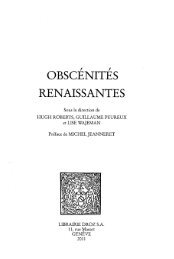Download (3398Kb) - ePrints Soton - University of Southampton
Download (3398Kb) - ePrints Soton - University of Southampton
Download (3398Kb) - ePrints Soton - University of Southampton
Create successful ePaper yourself
Turn your PDF publications into a flip-book with our unique Google optimized e-Paper software.
which has penetrated into the great depths and its features enable this species to<br />
inhabit depths above 3000 m where the environmental conditions are different. The<br />
base <strong>of</strong> the continental slope in the NE Atlantic occurs at ~ 3300 m (Rice et al., 1991).<br />
Howell et al. (2002) proposed that this may represent a barrier to abyssal species.<br />
They also found a tenuous relation between the depth at which abyssal fauna starts to<br />
appear and the depth at which North Atlantic Deep Water (NADW) and Modified<br />
Antarctic Bottom Water (MABW) meet between 3000 and 3500 m. Rogers (2000)<br />
provided evidence; which suggest that many abyssal groups have originated in the<br />
Southern Ocean, where Antarctic Bottom Water originates.<br />
The abyssal zone is inhabited by asteroid species with reproductive features<br />
indicative <strong>of</strong> equilibrium K strategists (Winemiller and Rose, 1992), which have low<br />
fecundity, large egg size and expected high juvenile survivorship, although their large<br />
body size makes them more comparable to the classical K strategists (MacArthur and<br />
Wilson, 1967; Pianka, 1970), and they are characteristic inhabitants <strong>of</strong> constant<br />
environments (Winemiller and Rose, 1992; McCann and Shuter, 1997).<br />
As Ramirez-Llodra (2002) concluded, the species that have colonized the<br />
different deep-sea environments have to be well adapted to their habitat in order to be<br />
successful and persistent. In the deep NE Atlantic the habitat has selected for species<br />
with specific reproductive traits, which provide them with successful and<br />
advantageous life history strategies (Eckelbarger, 1994; Eckelbarger and Watling,<br />
1995) as can be clearly observed in the upper bathyal zone between 700 and 1100 m,<br />
where the environmental conditions have selected for small species with low<br />
fecundity and large eggs, plus habits related directly or indirectly with suspension<br />
feeding. This species exhibit reproductive features associated to the opportunistic<br />
92
















